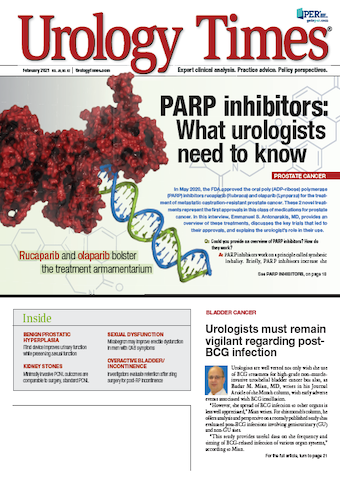Publication
Article
Urology Times Journal
Prostate cancer–related suicide declined over the past 20 years
Author(s):
The trend in prostate cancer aligns with an overall decline in cancer-related suicide across all tumor types.
Prostate cancer-related suicide decreased during the past 2 decades, according to an American Cancer Society (ACS) study published in the Journal of the National Cancer Institute (JNCI).1,2
The study assessed overall trends in cancer-related suicide and determined that across all tumor types, there was a 2.8% decline per year in cancer-related suicide. In prostate cancer specifically, there was a 5.1% decline per year.
The ACS investigators, led by Xuesong Han, PhD, senior principal scientist, Health Services Research, reviewed data from the Centers for Disease Control and Prevention’s Multiple Cause of Death database, 1999-2018. The database compiles information based on death certificates for US residents. Each death certificate provides “a single underlying cause of death, up to twenty additional multiple causes, and demographic data.”3
Overall, 738,743 suicides occurred during the 2-decade time frame, 6487 (0.9%) of which were determined to be cancer-related. The most common cancer types among these suicides were lung and bronchus (18.2%), prostate (15.4%), colon and rectum (9.1%), lymphoma and leukemia (7.4%), and head and neck (6.7%).
Among patients with lung and bronchus, lymphoma and leukemia, and head and neck tumors, cancer-related suicides declined 4.7%, 2.6%, and 3.7%, respectively.
There were also large declines in suicide rates among individuals who were aged 65-74 (-3%), aged 75-84 (-3%), male (-3%), and living in urban areas (-3.5%).
The researchers also assessed overall suicide rates over the same 20-year period. In contrast to the decline in cancer-related suicides, the overall suicide rate increase by 1.7% per year. There were significant increases across most subgroups, including all age groups ≤75 years, males, females, all census regions, urban areas, and rural areas.
“Using comprehensive death certificate data, we identified a decreasing trend of cancer-related suicide during the past 2 decades, despite the continuous increases in overall suicide rates in the United States. We observed the largest declines in cancer-related suicide rates among high-risk populations, including male, older age, and certain cancer types such as lung, prostate, and head and neck cancers,” Han et al wrote in their conclusion.”
“Although no causal relationship can be established, our findings suggest an evolving role of psycho-oncology care and palliative and hospice care given the promotion and increased utilization of these services among cancer patients during this period,” added the authors.
References
1. Cancer-Related Suicide Declined in the U.S. During the Past Two Decades. American Cancer Society. Posted online January 19, 2021. Accessed January 20, 2021. https://bit.ly/3iIfp6h.
2. Han X, Hu X, Zhao J, Ma J, Jemal A, Yabroff KR. Trends of Cancer-Related Suicide in the United States: 1999-2018. JNCI: The Journal of the National Cancer Institute; doi: 10.1093/jnci/djaa183
3. Multiple Cause of Death database, 1999-2019. Centers for Disease Control and Prevention. Accessed January 20, 2021. https://wonder.cdc.gov/mcd-icd10.html


























Real-time IRP monitoring may redefine safety and scope of flexible ureteroscopy
Telehealth in urologic cancer: Lessons learned from the COVID-19 pandemic
Published data support safety, efficacy of vaginal insert for SUI
Enrollment progresses in study for cisplatin-induced hearing loss in testicular cancer
2 Commerce Drive
Cranbury, NJ 08512
All rights reserved.







